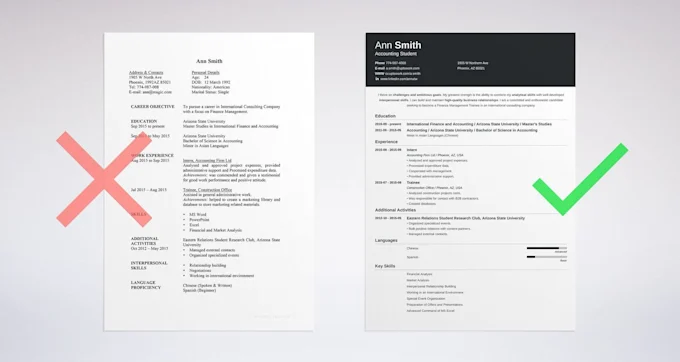Getting your resume ready for job applications in Texas starts with understanding how to organize it properly. Your CV formatting in Texas can make or break your chances of landing an interview. This guide walks you through everything you need to know about setting up your resume the right way.
Why Your CV Structure Matters
Your resume is often the first impression employers get of you. When hiring managers look at dozens of applications, they spend only seconds scanning each one. A well-organized document helps them find what they need quickly.
What Employers Look For
Recruiters want to see your information presented in a clear, organized way. They look for your work experience, education, and skills without having to search through messy formatting. When your CV formatting in Texas follows standard guidelines, employers can easily understand your background.
A properly formatted resume also shows attention to detail. It tells employers you care about quality and can follow instructions.
Key Elements of Proper CV Formatting
Your resume should include these main sections in order:
- Contact information at the top
- Professional summary or objective statement
- Work experience with dates and descriptions
- Education section
- Skills list
- Additional sections like certifications or volunteer work
Each section needs clear headers and consistent spacing. Use the same font style throughout your entire document.
Font and Size Guidelines
Stick with professional fonts like Arial, Calibri, or Times New Roman. Your text should be 10 to 12 points in size. Avoid fancy or decorative fonts that are hard to read.
Keep your margins between half an inch and one inch on all sides. This gives your resume breathing room and makes it look professional.
How to Structure Your Work Experience
Your employment history should show your most recent job first. Include the company name, your job title, and the dates you worked there.
Writing Job Descriptions
Under each position, add 3 to 5 bullet points describing what you did. Start each bullet with an action word like managed, created, developed, or improved. Be specific about your achievements rather than just listing tasks.
For example, write “Increased customer satisfaction by 25%” instead of “Handled customer calls.” Numbers and measurable results grab employer attention.
Education Section Best Practices
List your highest degree first, even if you attended multiple schools. Include your degree type, the school name, and your graduation year.
If you’re still studying, write “Expected graduation” followed by the date. Add your GPA if it’s 3.5 or higher, as this shows strong academic performance.
Creating an Effective Skills Section
Your skills section should list abilities relevant to the jobs you’re seeking. Group similar skills together for easier reading.
Organizing Your Skills
You might arrange skills by category like:
- Technical skills (software programs, tools)
- Language abilities
- Professional skills (project management, communication)
- Industry-specific knowledge
Keep your skills list to 10 to 15 items. Focus on abilities that match the job description in each position you apply for.
CV Formatting in Texas: Location-Specific Tips
Texas employers often look for candidates who understand the local job market. When applying for positions in Texas, California, New York, and Florida, adjust your experience descriptions to match what those regions value.
Regional Considerations
Different industries dominate different areas. If you’re applying to tech positions in California, emphasize software skills. For positions in New York, highlight corporate experience. Texas employers often value practical experience and results-driven candidates.
Always customize your resume for each application and region. This shows you’ve researched the company and position seriously.
Formatting Your Contact Details
Place your name at the top of your document in a larger font than the rest of your content. Include your phone number, email address, and city and state below your name.
You might add a LinkedIn profile link if it’s up to date. Skip personal information like your photo, age, or marital status unless the job posting specifically asks for these details.
Common Formatting Mistakes to Avoid
Don’t use more than two different fonts or change your formatting style between sections. Avoid adding colors or graphics unless you’re in a creative field. Keep your resume to one page if you have less than five years of experience.
Stay away from using personal pronouns like “I” or “me.” Let your accomplishments speak for themselves.
File Format and Submission
Save your resume as a PDF or Word document, depending on what the employer requests. PDF files preserve your formatting across different computers and printers.
Name your file something professional like “FirstName_LastName_Resume” instead of “My Resume.” This makes it easier for employers to organize applications.
Frequently Asked Questions
What length should my CV be? Keep your resume to one page if you have less than five years of experience. Two pages is acceptable for experienced professionals.
Can I use color in my resume? Simple use of one color for headers is okay, but stick mostly to black text. Too many colors look unprofessional.
Should I include references? Write “References available upon request” or create a separate references sheet. Don’t list actual references on your main resume.
How recent should my work history be? Include your last 10 to 15 years of experience. You can use “Additional experience available upon request” for older positions.
Does my resume need an objective statement? A brief professional summary works better than an objective. It shows employers why you’re interested in their specific company.
How do I format dates on my resume? Use “Month Year” format, like “January 2023.” Use consistent date formatting throughout.
Can I include personal hobbies? Only add hobbies if they’re relevant to the position or show important skills.
Final Thoughts
Your CV formatting in Texas and beyond doesn’t need to be complicated. Follow these straightforward guidelines to create a clean, professional document that employers will want to read. Spend time reviewing your work for spelling mistakes and consistency. A well-formatted resume opens doors to interviews and new opportunities in your career journey.


